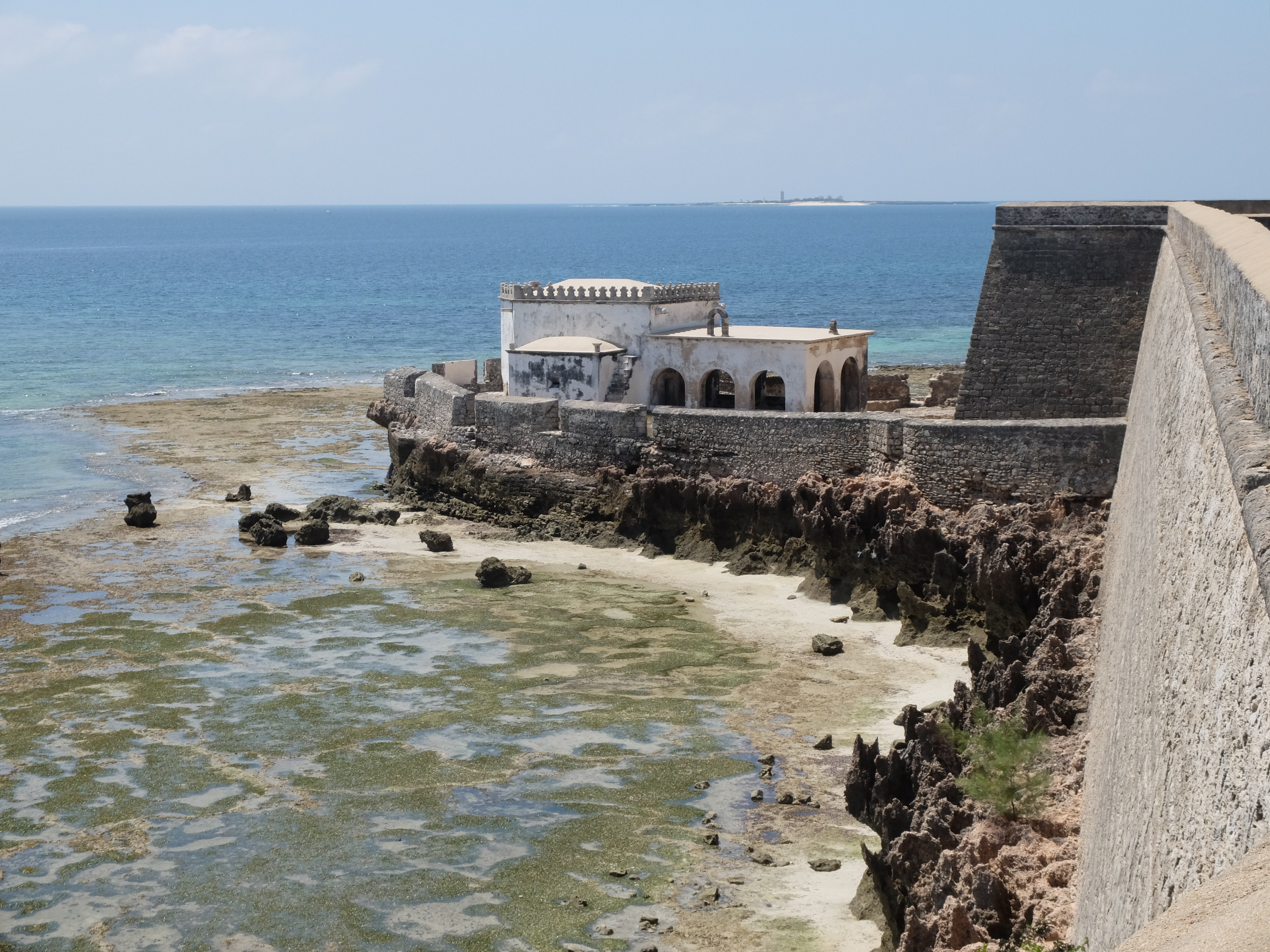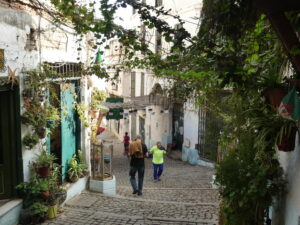In brief: Two towns, split between colonialists and natives, long served as key African ports. Despite years of decline, both still tell the past and foretell better futures…

They were vital ports once, both developed by invaders on sheltered islands in the archipelagos off the northern Mozambique coast just below Tanzania. For these outsiders, Ibo Island and Ilha de Moçambique (Mozambique Island, or just Ilha) gave them access to the interior resources of central and southern Africa.

First came the Omani Muslims out of Zanzibar and Somalia, trading in gold, ivory, wood, spices and slaves. Even today three-fourths of the islanders are Muslim. A few standing mosques date from the 1500s, and the calls to prayer sound out on both islands from new ones.
Then the Portuguese occupied the coast until 1974, leaving behind churches, forts, and diverse colonial era trading posts and residences, as well as their language and religion.

Of the two island towns, 3.5 kilometer long Ilha was the most important and, as a World Heritage site, remains the most impressive, for it was the colony’s capital city until 1898.
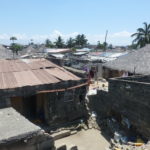
This was a divided island, split between the ruling colonial powers at the north end and the native people in the southern end. For centuries, stone was quarried from the native town called Makuti in order to build housing, churches and merchant buildings for the ruling class and traders at the north end. As a result, today, most of Makuti’s 14,000 people live in houses set down about a meter or two lower than the natural level of the land. Physically, a lower class.
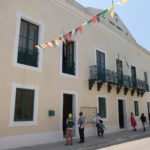
Their simple one story homes often topped by corrugated tin contrast markedly with the large tile-roofed multi-story stone and plaster buildings up north. That colonial part appropriately came to be known as Stone Town.

Stone Town had already declined by the time the capital shifted to Laurenco Marques (now Maputo) after the Suez Canal made southern African ports obsolete. After 1974, it deteriorated further. The grand 19th century hospital, the demarcation between Stone Town and Makuti, failed for lack of funds.

The striking Governor’s Palace, originally a 16th century Jesuit monastery, saw some fix-up a few decades ago due to its World Heritage status, but itself is barely holding on and needs restoration.

Despite the disrepair, we could wander old streets whose buildings recognizably date from each of the four centuries under the Portuguese, and back to the Arabs.
The old pier that juts out from the Governor’s Palace displays three centuries of development itself.

The 18th century fort Sao Sebastiao, a remarkable military outpost on the very northern tip of Stone Town, has many stories to tell, as well as nooks and crannies to explore. Centuries-old churches mark various points of the compass, including the oldest European building in the southern hemisphere, the small Chapel of Nossa Senhora de Baluarte from 1522.

That stands like a prayer, valiantly confronting the sea at the marshy edge of the fort.
Nonetheless, it seemed to us, outside of the few high season months, that the old colonial port had become a kind of dead city, with empty streets and a strange quietude.
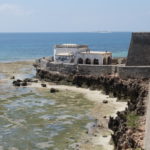
Few locals were there. The tourists are primarily interested in the beaches, surf and the underwater life of the archipelagos near the islands (click here to read the short article). They stop here just briefly to take a peek at the colonial past.

Nor do they linger in much more lively Makuti despite its fascinating mix of cultural influences from the past.
Fortunately, some signs of new life have begun in the unlively north. The flow of sybaritic tourists has increased with the end of Mozambique’s civil war and economic turmoil.

Many buildings are being renovated, including several boutique hotels rising out of the debris of the old colonial villas. People might stay a while, hosted by the new colonialists and traders: typically European operators of the renovated properties, outsiders with money and hosting experience. They employ local staff, but the opportunities for those in Makuti are limited.
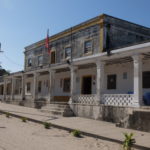
The second ancient port, Ibo is even more of a wreck, suffering from the same decline as Ilha, without the old investment as a capital. Two long streets angle west to form the dusty triangle of the old trading town.
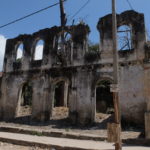
Simply porticoed buildings line the streets, some restored and freshened, mainly the places tourists now stay or shop for goods. Entering the plain interiors, you find a shady courtyard or perhaps a verandah backing onto the sea. But so many are barely habitable or derelict, such as the old customs house with its ironwork façade and the 17th century church in the main square.

These are not lovable ruins like old castles, but untended relics you need to project a lot of historical vision onto.
Historical tours try to do just that, virtually repainting the place with old stories of the trading days.
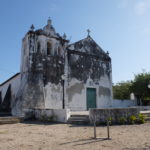
They even recruit the nonagenarian João Baptista, named for the fort constructed here by Arabs and Portuguese over the years, to tell tales of the revolution and his life under colonial rule.
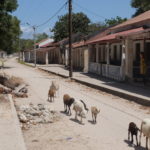
And of the split world here. While a few villagers have moved into the colonial buildings, most of them live apart in squat stick and mud huts sprawling eastward from the old port town.
With only stray tourists and villagers occasionally wandering about, the colonial streets of Ibo feel even more like a ghost town than Ilha. But development is happening here too, especially along the third leg of the triangle to the west.
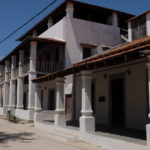
There a gracious old club is now the pricey Ibo Lodge and two new tourist villas are preparing to open. All the decayed buildings along the streets have been sold to outsiders, who await their opportunity to serve greater numbers of tourists when the time is right.

When they come, they will find a cadre of silversmiths already waiting, clogging the entrance to the old fort. Silver working is a craft mastered when the Arabs were here, and recently revived. When we visited the fort, it seemed that every tourist in town showed up at the same time, maybe a dozen or so in all.
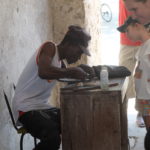
They pored over the elaborate pieces of jewelry, in patterns fashioned out of simple little pieces. They negotiated prices as low as a quarter of the ask.
But we just wanted a small spoon, typically our only souvenir from a country, customized with the name “Ibo” – via engraving or etching, we thought.

The assigned worker, earbuds piping music in his head under a Cincinnati Reds baseball cap, spent over an hour shaping delicate silver threads into the three tiny letters and carefully positioning them on the spoon. He fixed them solidly with some chemical, and then took a half hour more to polish the spoon into brightness.
The future of Ibo – and Ilha – may be just as bright.
(Also, for more pictures from Mozambique, CLICK HERE to view the slideshow at the end of the itinerary page.)


